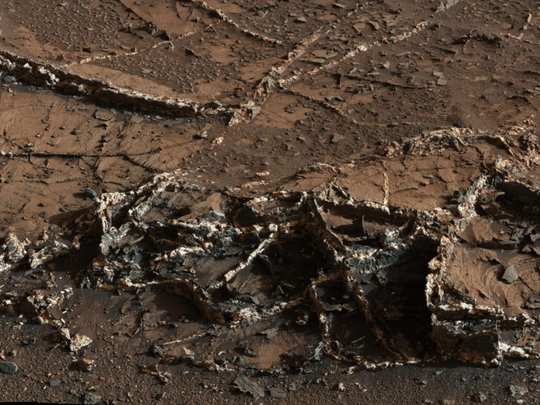
Climbing up Mt. Sharp in the middle of Gale Crater, Nasa’s Mars rover Curiosity has discovered two-tone veins of minerals that reveal multiple episodes of water flowing through rock -- even after the lake that once filled the bottom of the crater had ceased to be.
The rover’s discovery points to a very different kind of watery habitable environment than Curiosity has found before -- one that may also have been habitable for microbial life, if it ever existed on the Red Planet.
“Not only does this help us try to understand the chemistry of the rocks that we measure in the region, but on a different sort of scale it tells us that fluids were around on Mars for a long time,” said Linda Kah, a sedimentary geologist at the University of Tennessee, Knoxville and a member of Curiosity’s science team.
The duo-tone deposits, at a spot called Garden City, sit some 39 feet above the lower edge of the Pahrump Hills outcrop, which is part of the basal layer of the 3-mile-high Mt. Sharp. They feature both light and dark regions. They rise about 2.5 inches above the rock surface like ridges, because the rock that once surrounded them has worn away. These kinds of veins are formed when fluid flows through cracks in a rock and leaves some minerals behind.
Most veins have been bright and light-colored, Kah said, often filled with calcium sulfate. On Earth, such mineral deposits are often associated with salty water. But the dark deposits were somewhat unexpected, she said.
“There’s something very different about these veins than what we have seen prior,” Kah said.
The dark parts often seem to line either side of the white veins, rather like an ice cream sandwich -- a description Kah’s 10-year-old son Douglas came up with while looking over his mother’s shoulder at images of the deposits.
“I think they’re incredibly gorgeous and beautiful,” she said.
Whether appetizing or attractive, the two different tones are scientifically telling. Researchers look at Martian rocks in part to see how water (and the stuff in the water) may have affected a particular rock during a particular era. But if the same rock is getting soaked with very different kinds of water sources over time, then it may show a confusing mix of traits from a long period in which the environment dramatically changed over and over again.
That’s why the mineral veins are so helpful. The deposits in the cracks can look very different from the surrounding rock because they were formed much later than the rock itself. So while the rock’s chemistry and mineralogy will have been affected by multiple environments, the mineral veins offer a snapshot of at least one individual era in the Red Planet’s history.
In this case, the mineral veins actually offer snapshots into three environments. At first the scientists thought there were two different epochs, represented by the light and dark deposits, but it turns out that some dark spots are chemically very different from other dark areas.
“It was really very exciting for us,” Kah said. “Now we’ve just added complexity, so it makes it more fun to figure it out in the long run.”
Curiosity, which landed on Mars in 2012, has already found environments with the right chemical ingredients for life, as well as not-too-salty, not-too-acidic water. It has also turned up evidence of a lake that may have drained and filled over time.
The scientists think this environment existed long after the lake that once filled the bottom of Gale Crater dried up for good, and that these deposits were created by water under a significant amount of rock -- enough to exert the kind of pressure that would force the fluid to push through cracks in the stone.
It’s also unclear how hot or cold or acidic or salty this water was; the fluid’s chemistry could have been very different from the potentially potable liquid in that long-gone lake.
But it’s still quite possible that microbial life, if it ever existed, could have thrived in this environment, just as they thrive in the rock fractures at the hot springs of Yellowstone National Park, she added.












